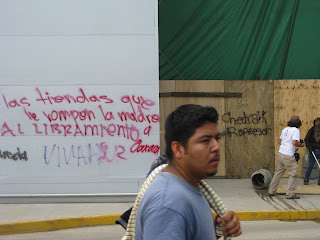Repression was rained upon the movement – causing folks to rally to one another’s aid, but also creating fear and intimidation. The protest energy could not be sustained. In the face of over a dozen assassinations by government forces, people got tired and scared – there was much handy work by police and paramilitaries to arrest, harrass, and assasinate participants. U.S. Journalist Brad Will was killed and an APPO member subsequently framed and arrested for his murder. Traditional political parties, seeing the opportunity to move the masses to get rid of their political opponents – particularly the governor - threw themselves into the protests which more and more galvanized around the removal of the governor but not much else. Demands and visions for change became muddied.
Today, the teachers union remains at the center of APPO, but with demands that are not entirely shared - labor demands to be able to pass on their teaching posts to their children – which is fantastic for the teaching family’s economy but not necessarily stellar for kids’ education. Demands representing the aspirations of ordinary Oaxacans (many of whom see the teachers as a privileged class - some of the few that have stable, formal employment) are not heard. Internal strife wracks the APPO with fierce debates about whether it ought to post political candidates or not. Its congress was taunted by anarchists that claimed APPO had become too institutional and was out of touch. Newspapers have become increasingly vicious about the APPO, blaming them for Oaxaca’s escalating violence. The escalating violence is not disputed – but most people blame the government for creating the environment of violence, not the APPO. The powerful have risen to the top of its ranks, leaving grassroots participation and leadership marginalized. At this point, close to 3 years after the original uprising, it’s hard to define what exactly what is the APPO and what is their strategy for change.
So what's to be done? The APPO can still mobilize hundreds of thousands of people - pretty amazing in a city of only half a million, but its demands aren't clear. It has been hard for APPO to shake the image of a street fighter to evolve into something different. Do you fold up the APPO and start afresh when a new moment presents itself to form another broad front? Or do you fight like hell to make the APPO fully representative and restore its glory? I attended their recent congress and watched people grow tired in a sea of argument.
Nevertheless on June 14th, on the third anniversary since the first round of repression against the uprising, the APPO brought out hundreds of thousands of protestors. The defiance turned to sadness when a car launching fireworks - a Oaxacan parade tradition - blew up and killed the rocketeer. The promised non-violence was marred by 30 or so marauding, bandana-covered anarchists who attacked symbols of political power and globalization en route. Peace marshals were too frightened to intervene. And despite these challenges, the APPO lives on!

A street barricade

Fresh, creative graffiti

My buddy Sergio and his buddy and son.

One anarchist - "University of Hate" and "We are not anything"


Attacking a department store, Chedraui, whose goons had been caught chainsawing trees in a neighborhood park, without authorization, to make way for a new mega store.







No comments:
Post a Comment